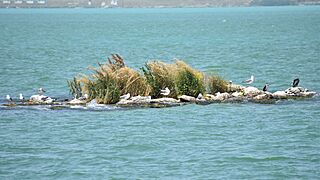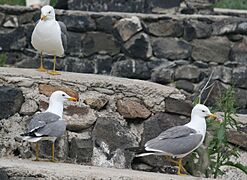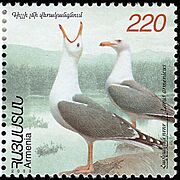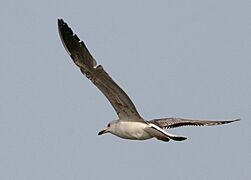Armenian gull facts for kids
Quick facts for kids Armenian gull |
|
|---|---|
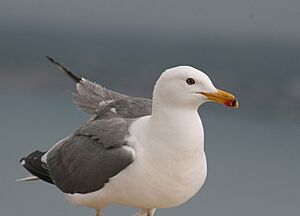 |
|
| Conservation status | |
| Scientific classification | |
| Genus: |
Larus
|
| Species: |
armenicus
|
 |
|
| Synonyms | |
|
Larus cachinnans armenicus |
|
The Armenian gull (Larus armenicus) is a type of large gull bird. You can find it in the Caucasus region and the Middle East. For a long time, people thought it was just a kind of European herring gull. But now, most scientists agree it's its own special species.
About the Armenian Gull
The Armenian gull is a fairly large bird. It is usually the smallest among the "herring gull" family. These gulls are about 52 to 62 centimeters (20 to 24 inches) long. Their wings can spread wide, from 120 to 145 centimeters (47 to 57 inches). They weigh between 600 and 960 grams (1.3 to 2.1 pounds).
What Does It Look Like?
Armenian gulls look a bit like yellow-legged gulls. However, they are a little smaller. Their backs are a darker grey color. They also have dark eyes. The black parts on their wingtips are larger. They have smaller white spots there too.
Their bill (beak) is short. It has a clear black band right before the tip. Young Armenian gulls are mostly brown. They have a white rump (the area above the tail). Their inner wing feathers are pale. They also have a thin, sharp black band on their tail.
Where Do Armenian Gulls Live?
Armenian gulls build their nests near mountain lakes. You can find them in countries like Georgia, Armenia, Turkey, and western Iran. The biggest groups of these gulls live at Lake Sevan and Lake Arpi in Armenia.
Migration Habits
These gulls do not stay in one place all year. Many of them fly south for the winter. They spend the colder months on the coasts of Turkey, Lebanon, and Israel. Smaller groups also travel to Cyprus, Egypt, and the Persian Gulf.
How They Breed
Armenian gulls build their nests on the ground. They often choose islands or the shores of lakes. The nest is made from a pile of plants.
Laying Eggs
Female gulls usually lay three eggs. This happens mostly in late April. Their nesting areas are very crowded. Nests are built close to each other. Because of this, fights over space are common among the gulls.
Gallery
-
Juvenile of Armenian gull in flight, flying over Lake Sevan



